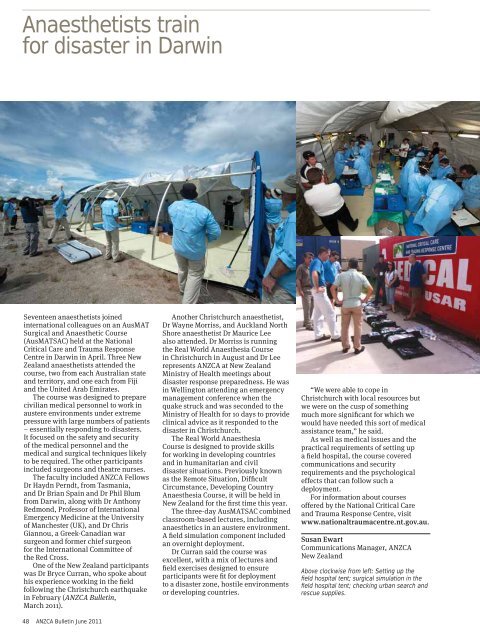ANZCA Bulletin June 2011 - Australian and New Zealand College of ...
ANZCA Bulletin June 2011 - Australian and New Zealand College of ...
ANZCA Bulletin June 2011 - Australian and New Zealand College of ...
You also want an ePaper? Increase the reach of your titles
YUMPU automatically turns print PDFs into web optimized ePapers that Google loves.
Anaesthetists train<br />
for disaster in Darwin<br />
Seventeen anaesthetists joined<br />
international colleagues on an AusMAT<br />
Surgical <strong>and</strong> Anaesthetic Course<br />
(AusMATSAC) held at the National<br />
Critical Care <strong>and</strong> Trauma Response<br />
Centre in Darwin in April. Three <strong>New</strong><br />
Zeal<strong>and</strong> anaesthetists attended the<br />
course, two from each <strong>Australian</strong> state<br />
<strong>and</strong> territory, <strong>and</strong> one each from Fiji<br />
<strong>and</strong> the United Arab Emirates.<br />
The course was designed to prepare<br />
civilian medical personnel to work in<br />
austere environments under extreme<br />
pressure with large numbers <strong>of</strong> patients<br />
– essentially responding to disasters.<br />
It focused on the safety <strong>and</strong> security<br />
<strong>of</strong> the medical personnel <strong>and</strong> the<br />
medical <strong>and</strong> surgical techniques likely<br />
to be required. The other participants<br />
included surgeons <strong>and</strong> theatre nurses.<br />
The faculty included <strong>ANZCA</strong> Fellows<br />
Dr Haydn Perndt, from Tasmania,<br />
<strong>and</strong> Dr Brian Spain <strong>and</strong> Dr Phil Blum<br />
from Darwin, along with Dr Anthony<br />
Redmond, Pr<strong>of</strong>essor <strong>of</strong> International<br />
Emergency Medicine at the University<br />
<strong>of</strong> Manchester (UK), <strong>and</strong> Dr Chris<br />
Giannou, a Greek-Canadian war<br />
surgeon <strong>and</strong> former chief surgeon<br />
for the International Committee <strong>of</strong><br />
the Red Cross.<br />
One <strong>of</strong> the <strong>New</strong> Zeal<strong>and</strong> participants<br />
was Dr Bryce Curran, who spoke about<br />
his experience working in the field<br />
following the Christchurch earthquake<br />
in February (<strong>ANZCA</strong> <strong>Bulletin</strong>,<br />
March <strong>2011</strong>).<br />
Another Christchurch anaesthetist,<br />
Dr Wayne Morriss, <strong>and</strong> Auckl<strong>and</strong> North<br />
Shore anaesthetist Dr Maurice Lee<br />
also attended. Dr Morriss is running<br />
the Real World Anaesthesia Course<br />
in Christchurch in August <strong>and</strong> Dr Lee<br />
represents <strong>ANZCA</strong> at <strong>New</strong> Zeal<strong>and</strong><br />
Ministry <strong>of</strong> Health meetings about<br />
disaster response preparedness. He was<br />
in Wellington attending an emergency<br />
management conference when the<br />
quake struck <strong>and</strong> was seconded to the<br />
Ministry <strong>of</strong> Health for 10 days to provide<br />
clinical advice as it responded to the<br />
disaster in Christchurch.<br />
The Real World Anaesthesia<br />
Course is designed to provide skills<br />
for working in developing countries<br />
<strong>and</strong> in humanitarian <strong>and</strong> civil<br />
disaster situations. Previously known<br />
as the Remote Situation, Difficult<br />
Circumstance, Developing Country<br />
Anaesthesia Course, it will be held in<br />
<strong>New</strong> Zeal<strong>and</strong> for the first time this year.<br />
The three-day AusMATSAC combined<br />
classroom-based lectures, including<br />
anaesthetics in an austere environment.<br />
A field simulation component included<br />
an overnight deployment.<br />
Dr Curran said the course was<br />
excellent, with a mix <strong>of</strong> lectures <strong>and</strong><br />
field exercises designed to ensure<br />
participants were fit for deployment<br />
to a disaster zone, hostile environments<br />
or developing countries.<br />
“We were able to cope in<br />
Christchurch with local resources but<br />
we were on the cusp <strong>of</strong> something<br />
much more significant for which we<br />
would have needed this sort <strong>of</strong> medical<br />
assistance team,” he said.<br />
As well as medical issues <strong>and</strong> the<br />
practical requirements <strong>of</strong> setting up<br />
a field hospital, the course covered<br />
communications <strong>and</strong> security<br />
requirements <strong>and</strong> the psychological<br />
effects that can follow such a<br />
deployment.<br />
For information about courses<br />
<strong>of</strong>fered by the National Critical Care<br />
<strong>and</strong> Trauma Response Centre, visit<br />
www.nationaltraumacentre.nt.gov.au.<br />
Susan Ewart<br />
Communications Manager, <strong>ANZCA</strong><br />
<strong>New</strong> Zeal<strong>and</strong><br />
Above clockwise from left: Setting up the<br />
field hospital tent; surgical simulation in the<br />
field hospital tent; checking urban search <strong>and</strong><br />
rescue supplies.<br />
48<br />
<strong>ANZCA</strong> <strong>Bulletin</strong> <strong>June</strong> <strong>2011</strong>

















